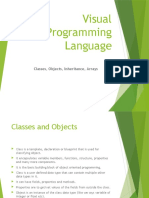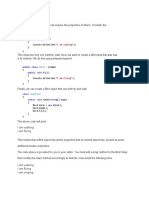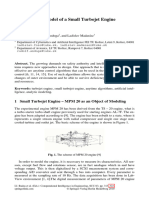C# Classes Syntax Steps
Uploaded by
Abdiel CorroC# Classes Syntax Steps
Uploaded by
Abdiel Corroclass Program
{
static void Main(string[] args)
{
// STEP 8 : Create an OBJECT of the Bird class (in this case using dot notation)
Bird falcon = new Bird();
// STEP 9 : give values to the BIRD members
falcon.beakShape = "raptorial";
falcon.nesting = "scrapes";
falcon.numSpecies = 19;
falcon.migration = true;
// ANOTHER CLASS OBJECT I commented for example purposes using object initializer
// Reptile turtle = new Reptile() { numSpecies = 356, reproduction = "eggs",
//isDangerous = false, canRegenerate = false};
// STEP 10 : in this case it is printing the info. Here we create an array and a
// foreach loop to be able to iterate to each member, property of the two classes
// the bird class and the reptile class (this one is commented).
var animalInventory = new Animal[] { falcon, turtle };
foreach (var item in animalInventory)
{
Console.WriteLine(item.GetType().Name);
Console.WriteLine($"Can swing: {item.canSwing}");
Console.WriteLine($"Animal group: {item.groupOrClass}");
Console.WriteLine($"Can Fly: {item.canFly}");
Console.WriteLine($"Fertilization: {item.fertilization}");
Console.WriteLine();
}
}
}
// STEP 1 : Create the BASE class
public class Animal
{
// STEP 2: Creating a CONSTRUCTOR (in windows we need to create it manually)
public Animal() //how do I know? It looks like a method without the return type and
{ // it has the SAME name that its class “Animal”.
}
// STEP 3 : Give this class MEMBERS (in this case, members that all Animals have in common)
public bool canSwing { get; set; } // these are properties because get & set keywords
public string groupOrClass {get; set; } // these are properties
public bool canFly { get; set; } // these are properties
public string fertilization { get; set; } // these are properties
}
// STEP 4 : Create the DERIVED class
public class Bird : Animal
{
// STEP 5 : Create a CONSTRUCTOR for this class
public Bird()
{
// STEP 7 : initialize the BASE members in the derivate class
canSwing = false;
groupOrClass = "neornithes";
canFly = true;
fertilization = "internal";
}
// STEP 6 : Give this class MEMBERS
public string beakShape { get; set; }
public string nesting { get; set; }
public int numSpecies { get; set; }
public bool migration { get; set; }
}
You might also like
- Lesson 1 Introduction To Object Oriented ProgrammingNo ratings yetLesson 1 Introduction To Object Oriented Programming6 pages
- By Stu: Belqes Bolghith Ahmad ID: 201917136 Class Number: 869No ratings yetBy Stu: Belqes Bolghith Ahmad ID: 201917136 Class Number: 8698 pages
- Defining Classes: Classes, Fields, Constructors, Methods, PropertiesNo ratings yetDefining Classes: Classes, Fields, Constructors, Methods, Properties33 pages
- 14 Defining Classes 110627100154 Phpapp01No ratings yet14 Defining Classes 110627100154 Phpapp0157 pages
- 23# Abstraction INTERFACE Object Oriented ProgrammingNo ratings yet23# Abstraction INTERFACE Object Oriented Programming5 pages
- Visual Programming Language: Classes, Objects, Inheritance, ArraysNo ratings yetVisual Programming Language: Classes, Objects, Inheritance, Arrays12 pages
- Public Int Public String Public Int String This This Public Void Int String This ThisNo ratings yetPublic Int Public String Public Int String This This Public Void Int String This This4 pages
- Week02 - Lab - Pet: Using Using Using Using UsingNo ratings yetWeek02 - Lab - Pet: Using Using Using Using Using5 pages
- Branching and Looping EX - NO:1 Date: Aim:: Program67% (6)Branching and Looping EX - NO:1 Date: Aim:: Program30 pages
- ClassPresentationSD224848LPushingRevittotheNextLevelAnIntrotoRevitPluginswithCJeremyGraham PDFNo ratings yetClassPresentationSD224848LPushingRevittotheNextLevelAnIntrotoRevitPluginswithCJeremyGraham PDF38 pages
- Ch3 Object-Oriented Programming in C#..No ratings yetCh3 Object-Oriented Programming in C#..39 pages
- (Object Oriented Programming) : Itprog3No ratings yet(Object Oriented Programming) : Itprog310 pages
- Assignment 4 Classes and Inheritance PDFNo ratings yetAssignment 4 Classes and Inheritance PDF2 pages
- Class - Collection of Objects Object - Instance of A Class Encapsulation - Process of Binding Data Members and Member Functions Into Single UnitNo ratings yetClass - Collection of Objects Object - Instance of A Class Encapsulation - Process of Binding Data Members and Member Functions Into Single Unit20 pages
- Java Programming Tutorial With Screen Shots & Many Code ExampleFrom EverandJava Programming Tutorial With Screen Shots & Many Code ExampleNo ratings yet
- 2010 - Mathematical Model of A Small Turbojet EngineNo ratings yet2010 - Mathematical Model of A Small Turbojet Engine10 pages
- Apc Back-Ups Pro 1500S, 1500va, Sinewave, 10 Outlets, 2 Usb Charging Ports, Avr, LCD InterfaceNo ratings yetApc Back-Ups Pro 1500S, 1500va, Sinewave, 10 Outlets, 2 Usb Charging Ports, Avr, LCD Interface3 pages
- Fuzzy Information and Engineering 2010, Vo - Bing-Yuan Cao PDFNo ratings yetFuzzy Information and Engineering 2010, Vo - Bing-Yuan Cao PDF830 pages
- Ultrasound Assessment of Gastric Content and VolumeNo ratings yetUltrasound Assessment of Gastric Content and Volume8 pages
- Philippine Agricultural Engineering Standard Paes 117: 2000No ratings yetPhilippine Agricultural Engineering Standard Paes 117: 200017 pages
- Huang_Proceedings the 3rd UCL OpenFOAM WorkshopNo ratings yetHuang_Proceedings the 3rd UCL OpenFOAM Workshop32 pages
- Powerwave Acoustic System Brochure PB1810 003No ratings yetPowerwave Acoustic System Brochure PB1810 0038 pages
- Full Download Exergy Energy System Analysis and Optimization Artificial Intelligence and Expert Systems in Energy Systems Analysis Sustainability 1st Edition Christos A. Frangopoulos (Editor) PDF DOCX100% (4)Full Download Exergy Energy System Analysis and Optimization Artificial Intelligence and Expert Systems in Energy Systems Analysis Sustainability 1st Edition Christos A. Frangopoulos (Editor) PDF DOCX81 pages
- G+5 RC Stair Design For Second Flight From Ground To First FLNo ratings yetG+5 RC Stair Design For Second Flight From Ground To First FL6 pages

























































































